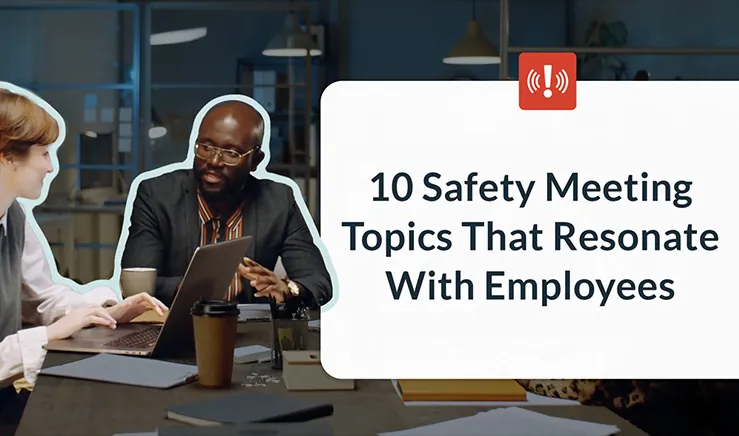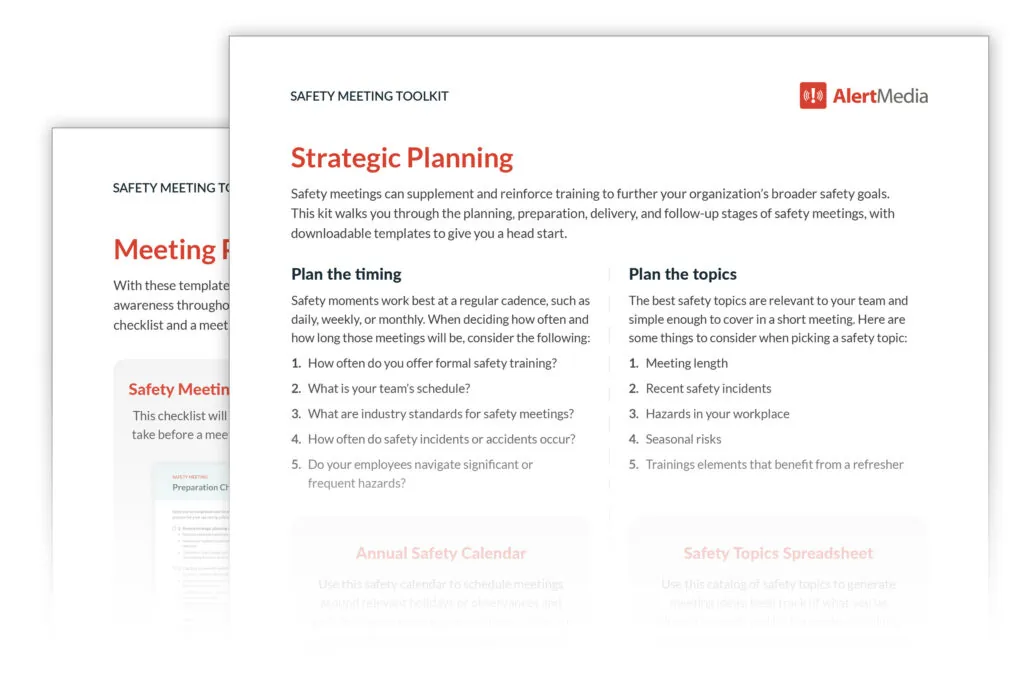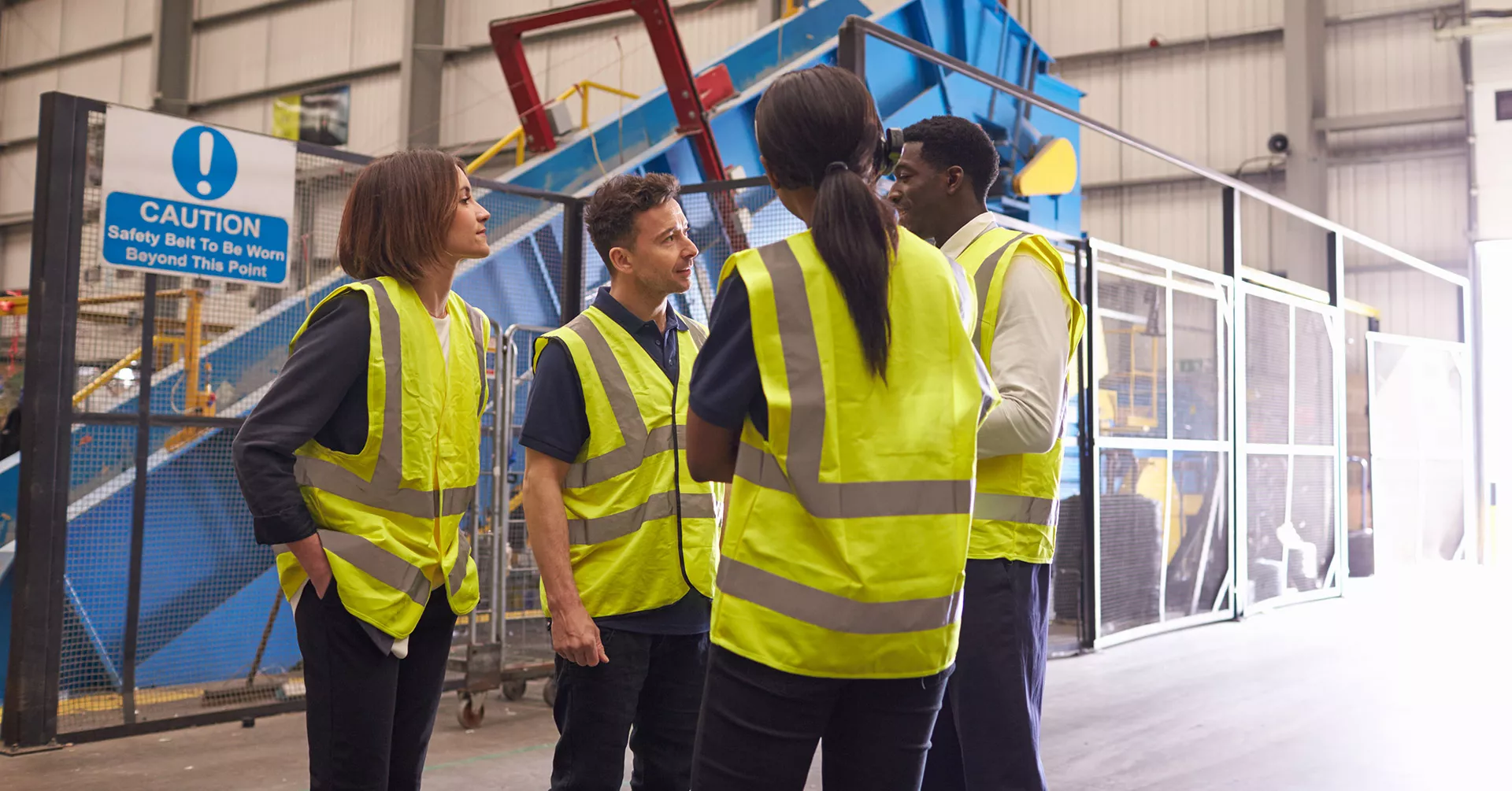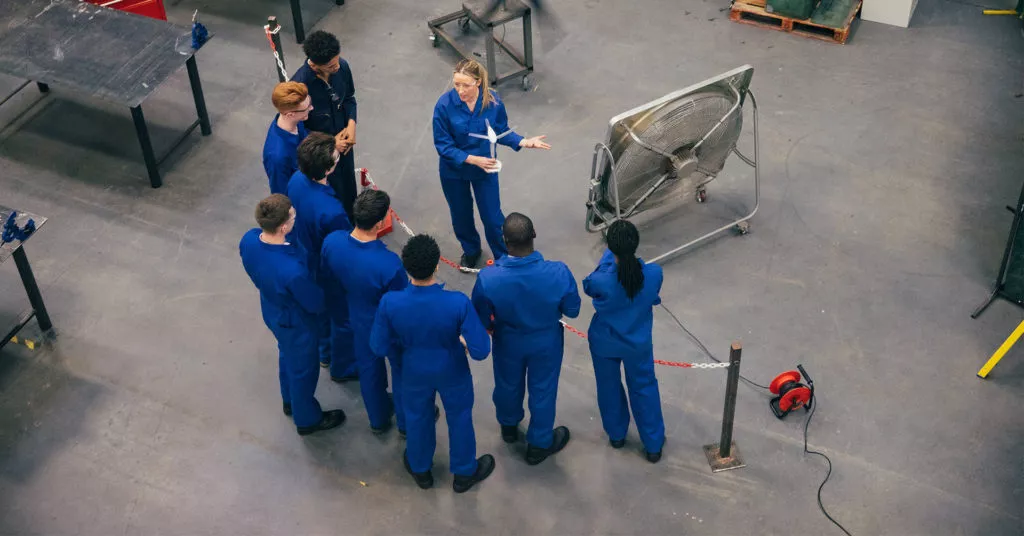
50 Safety Topics and Messages for Work
Leaving conversations about safety to quarterly meetings and occasional safety training means safety skills and awareness atrophy over time. Want a way to refresh critical concepts without losing everyone’s attention? We have you covered with safety-in-the-workplace topics.
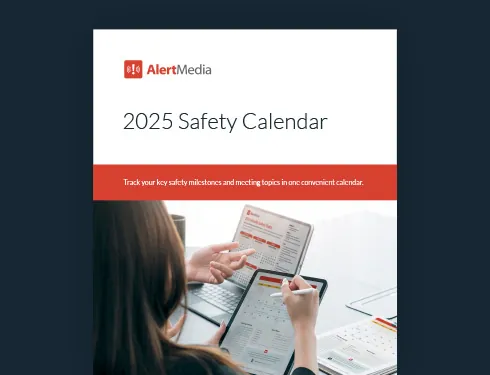
No matter what kind of work you do, it’s easy to become complacent, especially if you’ve spent most of your days performing familiar tasks on repeat. It can be tempting to cut corners and forego best practices in the interest of time, productivity, and effort. If you find yourself going down this path, be wary because skipping steps and ignoring rules could result in an avoidable emergency.
One way to prevent these lapses and complacency among your team is to present short safety topics regularly to remind everyone of proper procedures and prepare them for new hazards and variables they’ll encounter during the workday.
Download Our 2025 Safety Calendar
What Are Safety Talks in the Workplace?
Workplace safety talks are short, digestible, pre-work meetings about a particular safety topic that informs the work people are doing that day. These talks are most effective when kept short, focused, and memorable so workers can easily apply the advice right away and recall it over the long term.
Sometimes known as “safety toolbox talks,” “safety briefings,” or “safety moments,” safety talks can cover any number of topics as long as they’re related to worker and workplace safety.
How to Make Safety Topics for Work Engaging and Effective
Safety leaders tasked with devising short safety meetings tend to focus entirely on the talk’s content, ignoring its form. They may even forget that it’s their responsibility to engage people so they’ll absorb the information and be ready to use it.
Consider ways to maintain safety engagement and interest in your content. This is partly about what not to do. For example, an uber-professional tone could work against you. Your safety meeting topics won’t do much good if your audience falls asleep two minutes in. It’s also about active strategies to get people involved in the discussion and to get them to buy into the significance of their everyday safety efforts.
Ask questions
One of the main reasons people ignore meetings is that they believe they’re a waste of time because they won’t learn anything new. This can become a self-fulfilling prophecy; if they don’t think they’ll learn anything new, they’ll check out and miss the important information.
Counter this tendency by asking questions. When people realize they have an opportunity to speak their minds, they’re much more likely to become personally invested in the topic at hand. These questions shouldn’t put people in the hot seat but allow your frontline workers to give feedback.
Inject some humanity
When talking about safety practices, many speakers tend to become very formal and clinical in their language because they want to convey the seriousness of the topic and avoid distractions. Unfortunately, this can lead to disengagement, making your presentation ineffective.
Visual aids, humor, and analogies can add color to these talks and keep your people awake and receptive to the safety talk topic.
Reward engagement
It might sound diminutive, but who doesn’t like a mini candy bar? Try offering rewards for those who engage in the talks by asking poignant questions, helping others understand, or adding their own thoughts. Gift cards or other incentives work equally well.
Watch this video to learn the fundamentals of compelling safety talks, discover new topic ideas, and get facilitation tips.
Pro Tip: Keep a running list of safety-in-the-workplace topics. With it, you can not only prepare for upcoming safety talks but also integrate those meeting topics with broader emergency planning and preparedness efforts and involve various stakeholders. You can use the Topics Sheet from the Safety Meeting Toolkit to keep track of the topics you’ve gone through and what to cover next.
50 Safety Meeting Topics for work
The safety messages you incorporate in your safety talks and training sessions should be inspired by your work objectives and conditions. However, if you’re looking for some ideas to get you started, here are our suggestions.
Find more topic suggestions and talking points in the Safety Meeting Toolkit.
External Hazards
“The world is changing very, very fast…to be as flexible as possible–that’s what we’re doing every day.”
—Helmut Spahn, Director of Safety, FIFA
1. Electrical safety
Improper electrical distribution is a deadly hazard in the workplace. Electrocutions are one of the most common causes of injuries and fatalities on construction sites, and daisy-chained extension cords and power strips are a disturbingly common fire safety hazard. Promote fire prevention and avert workplace injuries by inspiring everyday accountability for safe electrical setup and operation.
2. Hot work safety
Heat stress prevention is key in many fields, especially those that require outdoor work during the summer months. It’s so important that OSHA is working on official regulations to require heat safety measures from many employers. Share heat safety tips with employees who work in the heat to keep people safe and maintain operational continuity.
3. Cold work safety
Cold weather can be deadly when preparedness efforts fall short. Share cold-weather safety tips with your team before a day of working in the cold, and set them up with a buddy system so all workers have someone who can look after them.
Pro Tip: We have a whole post dedicated to December and January safety topics. Check it out for more safety meeting ideas for the winter months!
4. Defensive driving
Workers who commute or drive for work can be faced with unpredictable dangers on the road. And distracted driving is a leading cause of motor vehicle accidents. It’s your duty to ensure employees’ safety while they’re on the road. Defensive driving skills are one of the best ways to ensure your team members get to their destinations safely. Emphasize the dangers of using phones, eating, or other distractions while driving. Encourage defensive driving techniques to reduce risks on the road.
5. Anti-phishing awareness
Phishing attacks—where bad actors send fake messages claiming to be someone else to gain access to restricted systems or resources—have increased year over year. These aren’t “hacks” in the traditional sense. They rely on basic social manipulation, not crafty coding or software vulnerabilities. Reminding workers how to spot phishing attacks can save your organization a lot of time, money, and trouble.
6. Active shooter awareness
While active shooter events are rare, they are becoming a greater strain on Americans’ mental health. Hold a safety meeting to go over your active shooter response plan, and reassure employees you’re looking out for their safety.
7. Work zone safety
Work zones, especially in construction or roadwork, present unique hazards like moving vehicles and heavy equipment. Ensure workers are visible with high-visibility clothing, follow proper signage, and stay alert to their surroundings. Regular safety talks can help reinforce work zone protocols.
8. Emergency preparedness for severe weather
Severe weather, such as hurricanes, tornadoes, or blizzards, can pose significant risks to workers. Review emergency plans, evacuation routes, and shelter-in-place procedures to ensure everyone knows how to stay safe during extreme weather events.
Individual Safety
“Safety is way more than compliance…it’s a moral imperative that we send people home to their loved ones.”
—Scott Gerard, VP of Environmental Health and Safety at Moss Construction
9. Personal protective equipment (PPE) review
Just as flight attendants remind passengers of the proper use of seatbelts, life jackets, and oxygen masks before every flight, you need to remind workers of the proper use of their PPE and safety gear so they’re more confident relying on it during an emergency. Common PPE—hard hats, safety glasses, respirators, fall protection harnesses, and high-visibility vests—could be the things that prevent serious injuries or death.
10. Particulate matter safety
Depending on the job site, small bits of liquid or solid material can be suspended in the air, which can wreak havoc on human bodies if inhaled. Some of these materials, like asbestos, are particularly dangerous. Use a safety topic of the day to remind everyone about signs of hazardous substance exposure and why PPE is important in these situations.
11. Tool safety
Some power tools and hand tools, from nail guns to chainsaws, have a natural level of risk associated with their use. You can gather your team at the beginning of a workday to remind them of the safety protocols for a particular tool and reduce those risks.
12. Personal health
An employee’s health is usually impacted by their private life more than it is by their work environment. Taking time to encourage healthy sleep and exercise habits, as well as attending annual medical check-ups, can help keep your workforce in peak condition.
13. Office ergonomics
Office workers might assume they don’t face any workplace hazards, but ergonomics should not be underestimated. Poor posture, inconveniently sized equipment, and other ergonomic problems can lead to carpal tunnel syndrome, joint pain, and other safety concerns. And with the rise of remote work, ergonomic risks have extended beyond the office. Provide remote workers guidance on setting up a home workspace with proper chair height, monitor positioning, and keyboard placement to prevent musculoskeletal disorders and promote long-term health.
14. Proper lifting techniques
We’ve all been there—we go to pick something up and underestimate its weight. When workers bend at the waist to lift, they risk seriously injuring their backs. Prevent these avoidable injuries by teaching proper lifting techniques as a quick safety topic.
15. Safe use of lifting equipment
Improper use of lifting equipment, such as cranes or hoists, can lead to serious injuries or equipment failure. To prevent accidents and ensure a safer workplace, provide training on load limits, inspection procedures, and safe operation.
16. Mental health & well-being
Mental health and well-being have increasingly become areas of focus across demographics, and this holds true in the workplace. Worsened by the isolation, loneliness, and despair many felt during the height of the COVID pandemic, people’s mental health is at serious risk. Show your employees you care and are there to offer resources and support.
17. Hearing protection
Exposure to noise levels above 85 decibels (roughly the volume of an electric blender) can cause permanent damage to workers’ hearing. And while OSHA requires organizations to provide hearing protection equipment, a safety talk about why they’re necessary and how to use them properly ensures workers are prepared to prevent injuries.
18. Substance abuse
Substance abuse has increased in recent years. If someone is under the influence on the job, the likelihood of an accident skyrockets. Show employees how to recognize signs that a coworker is struggling, and offer treatment and support resources to those dealing with drug and alcohol use disorders.
19. Hydration
No matter what kind of work you do, no matter where you do it, there’s always one thing your people absolutely need: water. Make sure everyone knows where they can find cool water and that they have the right (and the responsibility) to take regular breaks for water.
20. First aid refresher
First aid training is too detailed and intensive to perform during a 5-minute safety talk, but those few minutes are enough to fortify first aid skills among your employees. Potential areas of focus include a reminder of where all first aid equipment is located, the signs of a stroke, or an overview of the proper CPR compression technique.
21. Accessibility and inclusive safety
Creating a safer workplace means ensuring safety efforts are accessible to everyone, including employees with disabilities or those who require accommodations. This includes providing accessible training materials, such as captioned videos or large-print documents, and ensuring physical workspaces are designed with inclusivity in mind. By tailoring safety protocols to meet diverse needs and encouraging open communication about accommodations, you can ensure all employees can participate fully in safety programs and stay protected on the job.
22. Fatigue management
Fatigue can impair judgment, reaction time, and productivity, increasing the risk of accidents. Educate workers on the importance of adequate sleep, taking breaks, and recognizing signs of fatigue. Implement policies to manage work hours and reduce fatigue-related risks.
23. Preventing repetitive strain injuries (RSIs)
Repetitive motions, such as typing or assembly line work, can lead to RSIs like tendonitis or carpal tunnel syndrome. Teach workers about proper ergonomics, stretching exercises, and the importance of taking breaks to reduce the risk of RSIs.
24. Safe use of personal devices at work
With the rise of BYOD (Bring Your Own Device) policies, employees often use personal phones, tablets, or laptops for work. Address the risks of distracted driving, cybersecurity vulnerabilities, and ergonomic issues related to personal device use.
25. Respiratory protection
Respiratory protection is vital in environments with poor air quality or hazardous substances. Train workers on the proper use of respirators, fit testing, and maintenance. Regularly review your respiratory protection program to ensure compliance and effectiveness.
26. Preventing slips, trips, and falls
Slips, trips, and falls are among the most common workplace injuries. Regularly inspect work areas for hazards like wet floors, uneven surfaces, or cluttered walkways. Encourage workers to report potential risks and wear appropriate footwear to prevent accidents.
Safety Administration
“Part of being an effective emergency manager…is helping [workers] understand why it’s important to plan.”
—Jeffrey Trask, Risk Manager at ISO New England
27. Communication review
Even if you have the best emergency notification system, good message templates, and an awesome reporting workflow, your hazard communication efforts will fall flat if employees aren’t reading the messages. Take some time to remind everyone how these notifications work, where they come from, and what to expect. You can also confirm all employees’ contact information as a follow-up action item.
You can use the Follow-Up template from the Safety Meetings Toolkit to communicate after your safety talks.

28. Accident reporting
While you can do a lot to make accidents less common, it’s very difficult to eliminate them entirely. While you work toward that goal, consider a short safety talk to review standards, rigorous accident reporting procedures, and after-action reports. These will help prevent similar accidents or near misses in the future.
29. Importance of work stoppages
Some emergencies are made much worse by the “bystander effect.” When a worker feels that they don’t have the authority to stop an unsafe activity, they likely won’t step in when something goes wrong. They might instead opt to wait for a supervisor to make the call—but during an emergency, seconds matter. Hold a meeting to make sure everyone knows that they are within their right to stop any dangerous work and will not be penalized for doing so.
30. Safety culture
Your organization’s safety culture is the aggregate of attitudes, behaviors, and practices regarding safety. It’s key to developing a safe, productive, and caring workplace, but it can only be accomplished with continuous effort. Morning safety talks can keep up your momentum in prioritizing safety first.
31. Workplace access protocol
Who’s allowed on the work site? Who isn’t? What about clients, vendors, and guests? Take a moment to remind your team about proper access control, such as not holding the door open.
32. Labeling potential hazards
Labels for potential hazards like slippery floors or unexpected steps can go a long way in keeping everyone aware and decreasing slip, trip, and fall accidents. Some workplaces may also have dangerous chemicals or zones that are unsafe to enter when equipment is turned on, and warning labels can promote situational awareness.
33. Lockout/tagout (LOTO) procedures
Lockout/tagout is a critical component of any occupational safety program, ensuring equipment is properly shut off and cannot be restarted during maintenance or repair. A strong LOTO process prevents accidental machine start-ups, protecting workers from serious injuries or fatalities. Reinforce the importance of following LOTO protocols to create a safer workplace.
34. Occupational safety programs
A comprehensive occupational safety program is the foundation of a safer workplace. Regularly review and update your program to address new risks, ensure compliance with regulations, and foster a culture of safety. Encourage employee participation and feedback to continuously improve safety measures.
35. Chemical safety and hazard communication
Proper handling and storage of chemicals are essential to prevent accidents and exposure. Ensure workers understand Safety Data Sheets (SDS), proper labeling, and the use of PPE when working with hazardous materials. A strong hazard communication program is key to reducing risks.
36. Preventing workplace bullying and harassment
A safe workplace includes emotional and psychological safety. Address workplace bullying and harassment by promoting a culture of respect, providing reporting channels, and offering support to affected employees. A positive work environment enhances overall safety and well-being.
General Safety
“If workers aren’t following specific protocols, very drastic things can happen not only to them but to their coworkers.”
—Diana Warden, Director of Safety and Security at the Dallas Zoo
37. Situational awareness
No matter the environment and type of work, situational awareness is perhaps the single most significant habit that can keep employees safe. Hold a short safety talk to gauge how situationally aware your employees are. This evaluation will help you plan for more in-depth training to guide them in increasing awareness of risks they may face.
38. Ladder safety
There’s a reason ladders are associated with bad luck: They’re a deceptively deadly tool we frequently rely on. Proper ladder setup, use, and oversight can avoid painful and costly mistakes.
39. Forklift safety
Working with heavy machinery, including forklifts, can be dangerous without the proper training. Safety talks about safe forklift driving and handling are critical for those working with or even near these tools.
40. Safe use of hand tools
Hand tools, such as hammers, screwdrivers, and wrenches, are ubiquitous in many workplaces but can cause injuries if used improperly. This topic could cover the proper tool selection for the task, tool inspection for damage or wear, and techniques to avoid strain or injury (e.g., using the right grip and avoiding excessive force).
41. Safe use of power tools
Power tools, such as drills, saws, and sanders, are essential in many industries but come with significant risks if not used properly. This topic could cover proper training and certification for power tool use, tool inspection for damage or defects, and safe operating techniques, including the use of guards and safety switches.

42. Workplace violence
Workplace violence is increasingly common, particularly in service industries and healthcare. Talk with your employees about the types of workplace violence, warning signs, and prevention steps they can take, including how to identify and report potential violence through an open, non-punitive channel.
43. Emergency exits
Every indoor workspace should have clearly marked emergency exits as part of a fire evacuation plan. That plan requires you to regularly review these emergency exit routes with your team, especially if you’re working in a new, unfamiliar location or in case one or more exits become blocked in an emergency.
44. Heavy vehicle safety
Heavy vehicles—such as forklifts, trucks, cranes, and other heavy-duty machines—have the potential to cause damage to people and property. Make sure all workers are aware of the dangers and how to keep themselves and others out of harm’s way.
45. Safe handling of compressed gases
Compressed gases, such as oxygen, acetylene, or nitrogen, are common in many workplaces but can be extremely hazardous if mishandled. Train workers on proper storage, handling, and use of compressed gas cylinders, including securing them upright and checking for leaks.
46. Fire extinguisher use
Portable fire extinguishers are ubiquitous and extremely effective at protecting people and property from fire damage but only if they’re used properly. When holding a short fire safety talk about correct fire extinguisher use, try turning it into a game to see who has the best fire extinguisher aim.
47. Confined space awareness
Some confined spaces have respiratory hazards, engulfment hazards, electrical dangers, or any number of factors that make them more dangerous than your average crawlspace. These are often restricted by posted signage. Make sure your team knows who is and isn’t permitted in these spaces and what the signage looks like. Trenching work, pipework, and other assignments are associated with these risks.
48. Carbon monoxide safety
Dubbed the “silent killer” because it’s undetectable by humans, carbon monoxide is deadly and you must monitor for it, especially in the presence of flammable gasses, exhaust, and heaters. Ensure your employees know the signs of carbon monoxide poisoning and how to double-check that CO monitors are working properly.
49. Air quality monitoring
Poor air quality can lead to respiratory issues, long-term health problems, and reduced productivity. Whether it’s dust, fumes, or chemical vapors, monitoring air quality is essential for maintaining a healthy work environment. Equip workers with the knowledge and tools to identify and report air quality concerns.
50. Stress management in the workplace
Chronic stress can lead to burnout, reduced productivity, and even physical health issues. Teach workers to recognize signs of stress in themselves and others, and provide resources like mindfulness techniques or Employee Assistance Programs (EAPs) to help them manage stress effectively.
Every Day Can Be a Safe Day
Carving out small chunks of time to regularly review digestible safety topics goes far beyond just preparing your employees for individual hazards. By making these short safety talks a familiar fixture of everyone’s days, you ingrain the idea that safety is always the number one priority. But it’s not safe for safety’s sake—it’s expressly to protect your business, its operations, and its people so everyone can work confidently, without disruptions.

